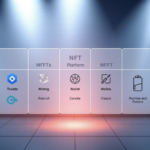Now Reading: How to Use Flash Loans: A Beginner’s Guide
- 01
How to Use Flash Loans: A Beginner’s Guide
How to Use Flash Loans: A Beginner’s Guide
Decentralized finance (DeFi) has transformed how people interact with money. One groundbreaking innovation is collateral-free borrowing, which lets users access funds without upfront deposits. These transactions rely on blockchain technology to ensure repayment happens instantly or gets canceled automatically.

Unlike traditional lending, this method uses smart contracts to enforce rules. Borrowers must return the assets, plus fees, within a single blockchain transaction. If they fail, the entire process reverses like it never happened. This “all-or-nothing” approach minimizes risk for lenders.
Common uses include exploiting price differences across exchanges or refinancing debt positions. However, these tools require technical knowledge to avoid costly errors. Beginners should start by understanding how atomic transactions and liquidity pools work.
Key Takeaways
- Collateral-free borrowing is unique to decentralized systems
- Repayment must occur within one transaction block
- Used for arbitrage, liquidations, and portfolio adjustments
- Smart contracts automate execution and security checks
- Requires careful planning to avoid financial losses
Introduction to Decentralized Finance and Flash Loans
Digital currencies have paved the way for trustless financial mechanisms that operate autonomously. At the heart of this innovation lies decentralized finance (DeFi), a system where transactions occur directly between users through automated protocols. This shift eliminates intermediaries while creating opportunities for novel financial tools.
What Are Flash Loans?
These unique financial instruments allow users to borrow assets without collateral, provided they repay everything in one blockchain transaction. Platforms like Aave and dYdX pioneered this concept, enabling strategies such as arbitrage or debt refinancing. If repayment fails, the transaction reverses automatically – a safety net traditional banks can’t offer.
The Role of Smart Contracts in Flash Loans
Self-executing agreements coded on blockchains make these transactions possible. They verify conditions like repayment amounts and timing without human oversight. For example, when accessing funds through leading crypto lending platforms, the contract ensures borrowed assets return to the pool before the transaction finalizes.
This system democratizes access to capital while maintaining security. Developers design these protocols to handle complex operations atomically, meaning every step succeeds or fails together. It’s a radical departure from legacy systems, showcasing blockchain’s potential to reinvent financial workflows.
How Flash Loans Operate Within a Single Blockchain Transaction
The backbone of collateral-free borrowing lies in blockchain’s ability to execute transactions atomically. This means every action either completes fully or reverses completely, eliminating partial outcomes. How DeFi flash loans work hinges on this principle, creating a financial safety net unseen in traditional systems.

Understanding Atomic Transactions
Blockchain processes bundles of actions as single, unbreakable units. If one step fails – like missing repayment – the entire operation cancels automatically. This “digital undo button” protects both lenders and borrowers.
For example, a user might borrow assets to exploit price differences across exchanges. The transaction only finalizes if profits cover the borrowed amount plus fees. Otherwise, the chain resets as if nothing happened.
Ensuring Immediate Repayment
Smart contracts enforce strict repayment rules within the same transaction block. They compare protocol balances before and after fund usage. If the required amount isn’t returned, the contract triggers an instant reversal.
This system allows sophisticated strategies without collateral risks. Failed attempts only cost gas fees, making experimentation feasible. Developers design these protocols to handle multi-step operations securely, ensuring no loose ends remain.
Flash loans: Mechanisms, Applications, and Risks
Instant access to substantial liquidity without collateral requirements marks a paradigm shift in decentralized finance. These mechanisms empower users to execute advanced strategies while maintaining blockchain’s core security principles. Let’s explore their transformative potential and inherent challenges.

Key Benefits and Capital Access
Uncollateralized borrowing breaks down traditional financial barriers. Users can tap into million-dollar liquidity pools for opportunities like arbitrage or debt refinancing. This levels the playing field between individual traders and institutional players.
Here’s why these tools matter:
- Enable profit from short-term price differences across exchanges
- Allow rapid portfolio adjustments without locked collateral
- Automatically reverse failed transactions, limiting losses to gas fees
Security Concerns and Price Oracle Vulnerabilities
While powerful, these mechanisms carry risks. Manipulating asset valuations remains a critical weak spot. Attackers can borrow large sums to distort prices on vulnerable platforms, draining funds from poorly secured protocols.
Developers combat these threats by:
- Implementing multi-source price feeds
- Adding transaction size limits during critical operations
- Conducting regular smart contract audits
Responsible usage requires understanding both possibilities and pitfalls. Platforms combining robust security with flexible access will likely lead DeFi’s next evolution.
Exploring Common Use Cases of Flash Loans
Blockchain-based lending unlocks creative financial strategies through instant capital access. Three primary applications dominate this space, each demonstrating how atomic transactions reshape traditional finance workflows.

Arbitrage Opportunities in DeFi
Traders exploit price differences between exchanges using borrowed assets. For example, buying ETH cheaply on Platform A and selling higher on Platform B within seconds. Profits cover fees while balancing market prices.
This strategy requires no upfront funds. Smart contracts ensure repayment occurs automatically if trades succeed. Failed attempts only lose gas fees, making low-risk experimentation possible.
Collateral Swaps and Liquidation Strategies
Users upgrade their loan positions without closing them. Imagine swapping BTC collateral for ETH to access better rates. The process happens atomically, avoiding liquidation risks during transitions.
Third parties also use instant loans to liquidate undercollateralized positions. Borrowed funds repay troubled loans, earning liquidation rewards. This keeps protocols solvent while rewarding quick-acting participants.
Advanced applications include:
- Refinancing debt across platforms for lower rates
- Optimizing yield through collateral rotation
- Executing multi-protocol strategies in one click
Flash Loan Execution: Code Insights and Practical Examples
Understanding the technical backbone of instant borrowing requires diving into smart contract architecture. The Ethereum community widely adopts EIP-3156, a standard ensuring consistent implementation across protocols. This framework simplifies development while maintaining security through predictable transaction flows.
Pseudo-Solidity Code Walkthrough
Here’s a simplified version of core functionality using Solidity-like syntax:
function flashLoan(uint256 amount) external {
uint256 balanceBefore = token.balanceOf(address(this));
token.transfer(msg.sender, amount);
IFlashLoanReceiver(msg.sender).execute();
if (token.balanceOf(address(this)) The code first records the initial token balance. After transferring funds, it triggers the borrower’s custom logic through execute(). Finally, it verifies repayment by comparing balances.
Transaction Reversion and Error Handling
Blockchain transactions automatically revert when conditions fail. If repayment checks detect insufficient funds, the entire operation cancels. This atomicity protects lenders while allowing users to experiment with strategies for earning through crypto assets.
Developers implement safeguards through:
- Clear error messages like RepayFailed()
- Gas optimizations for multi-step operations
- Receiver contract validation checks
Proper error handling helps users diagnose issues quickly. Contracts designed under EIP-3156 can interact seamlessly with various protocols, enabling complex strategies without collateral risks.
Integrating Flash Loans into Your DeFi Protocol
Effective protocol integration hinges on liquidity analysis and contract security. Leading platforms like Aave demonstrate how automated lending systems can operate safely at scale. Their infrastructure handles million-dollar transactions while maintaining blockchain’s core trustless principles.
Choosing the Right Protocol and Liquidity Pool
Aave and dYdX dominate this space with distinct advantages. Aave offers deeper liquidity pools across more assets, while dYdX provides specialized tools for advanced traders. Evaluate fees, supported tokens, and historical uptime before committing.
Prioritize protocols with multi-chain compatibility if building cross-platform solutions. Verify pool depth matches your borrowing needs – shallow pools increase slippage risks. Remember, even failed transactions incur gas fees.
Building Secure Receiver Contracts
Smart contract design separates successful implementations from vulnerable ones. Implement checks against reentrancy attacks and validate external calls rigorously. Use established libraries like OpenZeppelin for access control patterns.
Test contracts under extreme scenarios – sudden price drops or network congestion. Ensure repayment calculations include protocol fees upfront. Successful execution requires balancing speed with thorough validation at every step.
FAQ
How do decentralized applications enable uncollateralized borrowing?
Platforms like Aave and dYdX use smart contracts to allow users to borrow assets without upfront collateral, provided the borrowed amount plus fees is repaid within the same blockchain transaction. This eliminates traditional credit checks.
What ensures repayment in atomic transactions?
Atomic transactions either execute fully or revert entirely. If a borrower fails to repay the loan, the smart contract automatically cancels all actions, ensuring lenders never lose funds. This is enforced by code, not intermediaries.
Can price oracle manipulation affect loan security?
Yes. If a malicious actor exploits outdated or centralized price feeds, they could drain liquidity pools. Protocols like Compound mitigate this by integrating decentralized oracles such as Chainlink for real-time, tamper-resistant data.
How do arbitrage strategies benefit from instant capital access?
Traders leverage uncollateralized funds to exploit price discrepancies across exchanges. For example, buying an asset on Uniswap at a lower price and selling it on Sushiswap for profit—all within seconds, without risking personal capital.
Why are receiver contracts critical for protocol integration?
These contracts validate loan terms, execute custom logic (e.g., swaps or liquidations), and ensure funds are returned. Poorly audited code can lead to exploits, as seen in the bZx hack. Tools like OpenZeppelin libraries enhance security.
What happens if a transaction fails to repay the borrowed amount?
The entire transaction is reversed, erasing all intermediate actions. The blockchain resets to its original state, and the borrower only pays gas fees. No assets are transferred unless repayment occurs.
Which DeFi platforms offer the most reliable liquidity pools?
A: Balancer, Uniswap V3, and Aave V3 are widely used due to deep liquidity, low slippage, and robust audits. Always check pool metrics like TVL and historical stability before interacting.














